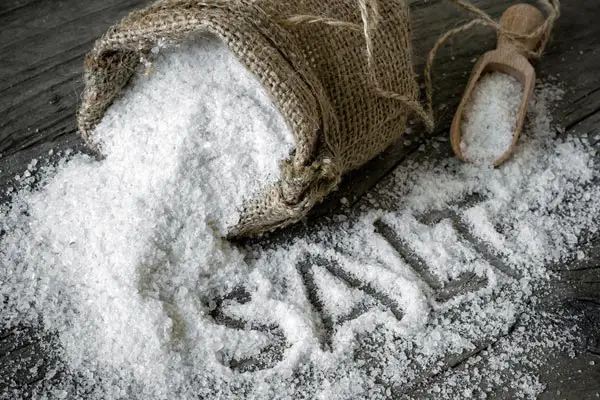SALTY DOG: Is It Okay If My Dog Eats Salt?
The Salty Dog is a cute name for a bar or restaurant, but in reality, salt can be harmful, even deadly to our canine friends.
In small amounts, salt ingestion may cause annoying diarrhea, but a larger intake can cause severe symptoms like seizures.
Dog owners can best protect their pets by educating themselves on the potential hazards and most common symptoms of salt poisoning. It doesn’t take much sodium to cause a problem for dogs.
Around 2-3 grams of salt per kilogram of body weight is enough to cause poisoning in a dog. Doses of about 4g per kg can be fatal.
So it stands to reason that smaller dogs are more susceptible to salt poisoning than larger dogs.
For example, a Shih Tzu that weighs 10 lbs (4.5 kg) would only have to consume 13.5 g of salt, or less than half a cup, to be in danger of sodium overdose.
Yet, a 70 lb (31.8 kg) labrador would need to eat over 4 cups for the same effect. Therefore, a special caution goes to small dog owners to be on alert for this potential issue.
The Most Common Causes of Sodium Overdose
Dogs can ingest salt in a variety of ways. Perhaps most common is a thirsty dog lapping up ocean water while out for some play and exercise in the surf.
However, even a ball or toy that is soaked in saltwater can cause too much salt intake.
According to Dr. Ken Tudor, owners should take breaks often and make sure their dog is drinking fresh water to reduce the temptation to drink from the ocean.
Limiting the length and frequency of visits to the beach can be helpful. Pet owners might look for a dog park or other recreation area with a lake or other freshwater source to avoid the problem altogether.
An additional saltwater source is saltwater pools. While sodium tablets can be a preferred method for pool disinfection, pet owners need to be aware of the danger of dogs using the pool as a water source.
Leaving a dog unattended in a fenced pool yard may not be wise. Without proper supervision, a dog might easily overdose in a misguided effort to quench its thirst.
Even worse, Fido might get into an unsealed bag of salt pellets and have a seizure or other catastrophic health event.
It’s best to leave the dog inside or in another part of the yard when you aren’t home.
Another danger zone for dogs and salt is during the snowy season when road salt is often used as an ice-melting measure.
Dogs can be tempted to eat the salty snow along a roadway during daily winter walks and even lick the residue off their paws once back indoors since it can be irritating to tender paws.
According to DailyPuppy, Pet owners also need to be vigilant about keeping snow-melt in closed containers and out of a pet’s reach. Even as little as a half-cup can be toxic to a mid-size dog.
It’s also worth considering the amount of sodium in your dog’s daily diet. Some sodium is necessary for proper bodily function and development.
In fact, the Association of American Feed Control Officials(AAFCO) recommends 0.3% sodium as a minimum ingredient in dog food. Dogs are not getting excessive salt in their commercial pet food.
Not surprisingly, most salt overdoses occur from pets eating people food like chips and pretzels either by accident or intentionally.
According to CanIGiveMyDog, While a small amount is probably okay, frequent “human” high sodium treats are not good for your dog.
Instead, dogs can safely eat treats like peanut butter and carrots, or better yet, stick to the dog treats made especially for pets.
For a more complete list of foods, dogs can and can’t eat check with the American Kennel Club.
Additionally, some dogs with certain health conditions like kidney, liver, and heart disease need to be on a special reduced-sodium diet.
Even small amounts of sodium can increase blood pressure and worsen the symptoms of congestive heart failure.
And dogs with kidney disease need to stay properly hydrated to help flush the kidneys which can be challenging with increased sodium consumption.
Regular visits to your vet are the best idea to monitor healthy salt levels in an at-risk dog, or any dog really.
Dog owners need to be aware of potential non-food household products that also have an especially high salt content.
A seemingly harmless homemade play-doh known as the salt dough is made up of salt, flour, and water. A typical recipe calls for 1 cup of salt.
If eaten, the salt dough would be enough sodium to cause trouble for a dog up to 20 lbs and a 10 lb dog would probably die of an overdose.
Other products that contain sodium chloride include laundry detergent and some shampoos. Store these items away from curious pets.
If you know your dog has ingested a high sodium product or other known poison, after calling the vet, the best option may be to induce vomiting.
The cheapest and most efficient method is to give the dog a small amount of hydrogen peroxide.
Get specific video directions here from Dr. Steve Weinberg. Even if vomiting is induced and you believe the toxin has been regurgitated, a visit to your vet is still the best follow up to make sure none of the poison has entered the dog’s system.
What’s the Big Deal?
Salt poisoning, more formally known by the scientific name hypernatremia, can be deadly. It can quickly affect the body on a cellular level.
According to pubmed.gov, the condition results from salt to sodium imbalance that can be caused by too much salt or not enough water in the cells, most likely from dehydration. Such imbalance can make hypernatremia very dangerous, even deadly.
A rapid shift in water levels in the cells can cause brain damage and hemorrhaging leading to a coma or death. In short, too much salt can wreak havoc on the whole body.
Don’t panic. Studies show that ingestion is a less common cause of sodium elevation in the blood.
More commonly, a dog can suffer from hypernatremia due to water loss from diarrhea, diabetes or renal failure.
Eating an individual packet of salt may make your pooch thirsty for a while but it is surely not a life-threatening issue.
Yet, eating a whole canister of Morton’s table salt should prompt a visit to the vet, especially if your dog is on the smaller side.
Still, veterinarians caution against allowing a dog to consume saltwater, salty snow or salty treats as although the odds are low, there remains a possibility of resulting dangerous salt levels that can be damaging.
Signs and Symptoms of Too Much Salt
Acute hypernatremia is a sudden change in blood sodium levels, while chronic hypernatremia is a more gradual rise in sodium levels commonly due to an underlying illness such as diabetes, heart failure, or kidney disease as mentioned above.
Mild hypernatremia is usually the result of overheating and dehydration and can make a dog extra thirsty. Moderate to severe sodium poisoning can have additional signs.
According to WagWalking, Symptoms include extreme thirst, excessive urination, weakness, sleepiness, confusion, depression, walking in circles, muscle twitching or trembling, vomiting, diarrhea, seizures, and coma.
Moderate to severe hypernatremia can be life-threatening if not treated properly.
If you notice your dog acting strangely with any of the above symptoms, prompt medical attention is warranted. Simply giving your dog extra water will not be adequate.
Pet owners should be aware of the closest emergency vet hospital in case such signs become visible during hours when your primary vet office is closed. Severe cases may not wait until the next business day.
Pet owners need also be prepared for the potentially exorbitant cost of emergency veterinary care.
Treatment can range from several hundred to several thousand dollars depending on necessary tests and length and type of specialized treatment.
Unless you have pet insurance, your wallet will surely take a huge hit. While a monetary value can’t be placed on a beloved pet, knowing the probable cost in advance will at least prevent the shock when the bill arrives.
Is It a Salt Overdose?
Once a dog has been brought into the office due to suspected salt poisoning, the doctor will take care to evaluate the dog with a complete physical exam to rule out any other causes.
Tests will most likely include blood pressure, temperature, and heart rate. Blood and urine tests can detect excess sodium, but other tests like x-rays, MRIs, and ultrasounds might be warranted if the vet suspects the issue to be chronic and not a direct consumption issue. Depending on the diagnosis, the dog may need to be hospitalized for treatment.
Treatment for high sodium depends on the underlying cause. If the dog has ingested too much salt via saltwater or other means, the common treatment is introducing IV fluids to re-balance the sodium levels and careful monitoring of blood levels over a few hours.
Chronic high sodium levels require more careful gradual fluid therapy over several days to avoid possible edema.
Rushing the number of fluids could make things worse and cause brain shrinkage and irreversible neurological issues.
An experienced doctor will want a thorough evaluation and confident diagnosis before deciding on which treatment is best to avoid causing more serious injury. This may take some time to accomplish.
Back to Normal
Once your dog has been successfully treated for salt poisoning, you’ll want to keep a close watch on him to be sure there are no recurring symptoms.
Fido might be more tired than normal but should otherwise have no behavioral irregularities.
You’ll want to keep up with follow up visits to the vet and return sooner if you notice anything amiss.
Otherwise, keeping your pooch away from the original poison source is the only long-term requirement to ensure continued recovery.
An Ounce of Prevention is Worth a Pound of Cure
Avoiding the common causes of sodium poisoning is easier than treating the illness and paying those high vet fees.
The following tips can help keep your dog healthy, happy and salty in person only.
At the beach:
When taking your pup to the beach, make sure she drinks plenty of water before you go to stave off potential problems with slurping saltwater.
A rubber ball is better to play fetch with than a more absorbent tennis ball or koosh ball that tends to absorb more seawater.
Keep ocean swimming to 15-minute durations with ample time to rest and drink fresh fluids for you and your dog.
In the snow:
In winter walk your dog away from roadside cinders and sidewalks where salt is heaviest. Instead, try plowed park trails or the yard where snow is less treated.
If you must walk your dog on the street or sidewalk where the salt mixture is present, consider outfitting your pooch with winter booties made for this purpose.
They will keep your dog from licking residue of paws as well once indoors.
Keep any salt-melt mixtures high on a shelf or tightly closed in a container with a secure lid.
Around the house:
Store salty people-food on high shelves or behind closed pantry doors where Fido can’t help himself while you’re out.
Always supervise a pet around a saltwater pool and offer plenty of fresh water for drinking.
The bottom line is that, although rare, sodium poisoning in dogs is a real danger.
Dog owners should take every measure to ensure that Fido does not fall prey to this hazard to being mindful of potential issues.
Prevention might require less playtime at the beach, a different walking route and careful storage of some household items, but ultimately a healthy pet is worth the effort.






